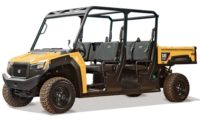
SUMMERHAYS
Employers are often surprised to learn that injuries sustained in a motor-vehicle crash may be compensable under the workers compensation laws of several states. Fleet exposure is one of the most overlooked loss sources of a company's operations. This is even true when a company�s transportation needs are incidental to what the company does and the type of employees the company has on staff.
Driver Selection
Do an interview that asks specific questions about an applicant’s driving experience and type of vehicles they will be driving. Get a copy of the applicant’s motor vehicle record and then test the applicant. You may want to do some or all of the following: written exam, road test, skills test, pre-trip inspection test, psychological evaluation, credit and background checks and physical exam.
Driver Training
Hiring is only the beginning. You should be training new and current employees concerning your company’s safety policies and procedures in accordance with any applicable regulatory standards. Training is a must if you want employees to be successful and perform safely.
Supervision
Once employees are trained and on the job, your firm should implement an ongoing employee supervision program. Supervision can be done in many forms. Call in procedures, radio, wireless phone, satellite communications and onboard tracking systems, road observations, driver surveys, in-house spot radar checks and 800 number “How’s My Driving” programs are a few examples of supervision techniques.
Vehicle Maintenance
Well-maintained vehicles avoid costly down time, accidents, repairs, insurance costs and fines. Avoid operating your fleet in a crisis-maintenance or fix-it-when-it-breaks mode. A good preventative maintenance and inspection program that involves all drivers will save you money in the long run.
Vehicle Occupancy Protection Systems
Establish and implement a company seat belt policy. Require your employees to always buckle-up no matter how big or small their vehicle. Combined with other occupancy protection system devices in today’s vehicles, the seat belt is the main component in preventing death and serious injury that can occur from a crash.
Distracted Driving
Driver distractions are nothing new. The use of cell phones is a major contributor to automobile crashes. Between 4,000 and 8,000 crashes related to distracted driving occur daily in the United States. In a year, they contribute to as many as one-half of the 6 million U.S. crashes. Establish and implement a company driving and cell phone policy.
Federal employees are not allowed to use cell phones while driving, according to an executive order signed by President Obama last year. The order covers federal employees when they are using government-provided cars or cell phones and when they are using their own phones and cars to conduct government business.
A recently released study by the Virginia Tech Transportation Institute found that truck drivers who were texting were 23 times more at risk of a “crash or near crash event” than “nondistracted driving.”
Driving may be one of the most dangerous tasks that employees do, but if you follow these simple steps this task can easily be performed safely.
div id="articleExtras"


Post a comment to this article
Report Abusive Comment